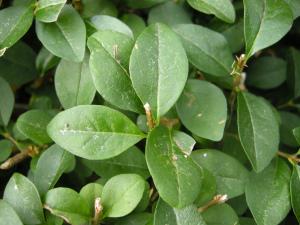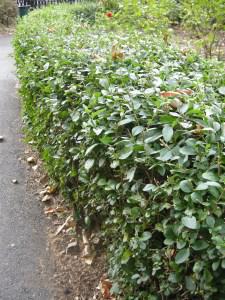
Ligustrum ovalifolium leaf (15/08/2011, London)
Position: Full sun and partial shade
Soil: well drained soil
Flowering period: Summer
Eventual Height: 5m
Eventual Spread: 5m
Hardiness: USDA Zone 8a-10b
Family: Oleaceae
Ligustrum ovalifolium is an evergreen shrub with a dense, upright habit. Its foliage is glossy, mid green, ovate and pointed, with entire margins. In midsummer it bears dense racemes, composed of small, mildly unpleasant scented, tubular white flowers. These are followed by small black fruits that are attractive to birds.
L. ovalifolium, commonly known as Oval-Leaved Privet, is native to eastern Asia including Japan.
Ligustrum was an old name for the Privet plant, with ovalifolium being derived from the Latin, meaning ‘oval leaved’.

Ligustrum ovalifolium (15/08/2011, London)
The landscape architect may use this plant as an evergreen low maintenance medium height (1m – 1.8m) hedge. It may be pruned to form a formal or flowering informal form. It is tolerant of droughts once established, is tolerant of salty, maritime conditions and it is tolerant of urban pollution. Care should be taken in locating this plant as its fruit is mildly toxic to humans when ingested.
The Royal Horticultural Society gave the cultivar Ligustrum ovalifolium ‘Aureum’ their prestigious Award of Garden Merit in 1993.
This plant will tolerate almost any soil conditions; it will be happy at neutral, acid or alkaline pH levels, in loam, chalk, clay or sand based soils, facing any sheltered or exposed aspect. L. ovalifolium may be prone to honey fungus attack.
Ecologically this plant will attract many species of pollinating insects such as honey bees and butterflies. It will also attract various species of birds which will feed on its fruit and shelter from predators in its foliage.
Maintenance: If maintaining a hedge, formal or informal, this plant should be trimmed after flowering. It may then be pruned a further 3 or four times during the summer months. Privet hedges will become denser the more they are pruned. This plant will withstand heavy pruning.

